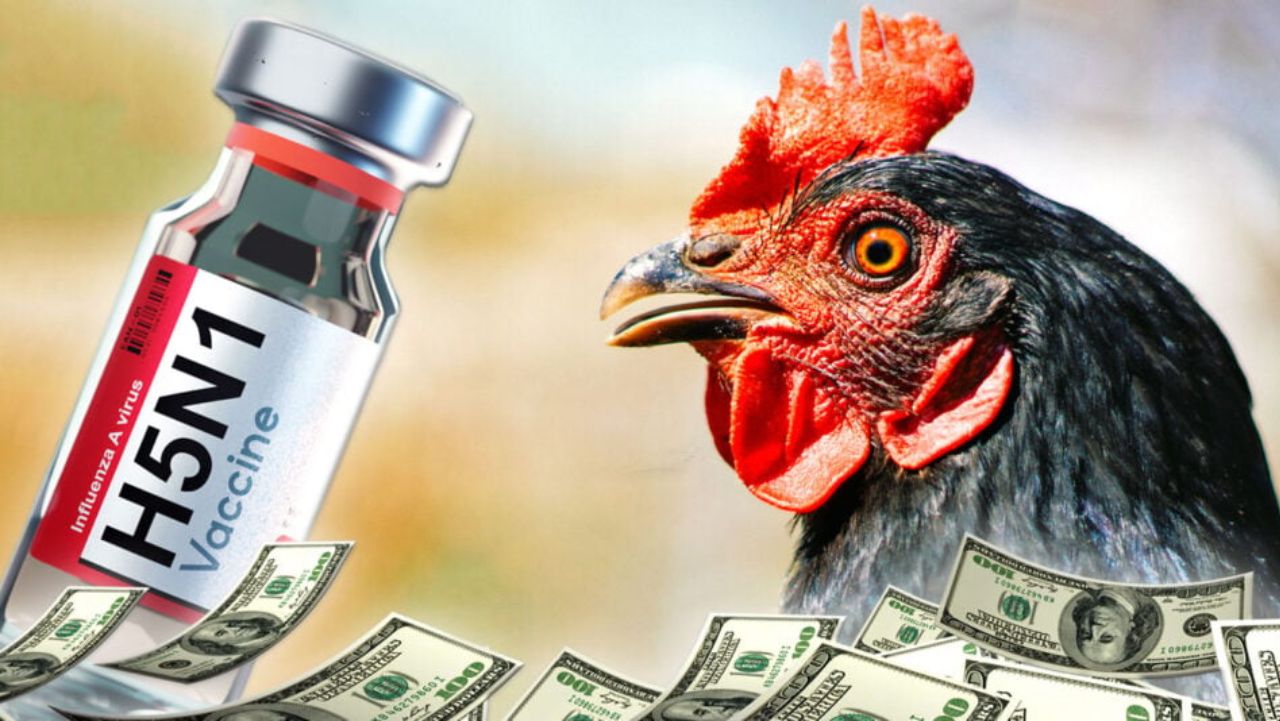Health
Bird Flu Vaccine for Humans ‘Ready for Mass Production’
Everything you need to know about gain-of-function research on bird flu and vaccines.

This article originally appeared on The Defender and was republished with permission.
Guest post by Michael Nevradakis, Ph.D.
Dr. Richard Bartlett, an emergency room director and former Texas Department of Health and Human Services advisory council member, joined “The Defender In-Depth” this week to discuss the latest media and government reports about bird flu, following the detection of the H5N1 avian influenza virus — also known as “highly pathogenic avian influenza (HPAI) A.”
H5N1 and related strains have been identified in birds, poultry, cattle, mammals including cats and dolphins, and humans in Texas and Vietnam.
The New York Times reported there is a risk the virus could mutate and become transmissible between humans, and the Daily Mail claimed a new bird flu outbreak could be “100 times worse than Covid.”
Dr. Mandy Cohen, director of the Centers for Disease Control and Prevention (CDC), said her agency is taking the situation “very seriously.” Suresh Kuchipudi, Ph.D., chair of the Infectious Diseases and Microbiology department at the University of Pittsburgh, said, “We are getting dangerously close” to a bird flu pandemic.
According to Bartlett, the latest bird flu outbreak follows “patterns” similar to those seen during the COVID-19 pandemic.
Bartlett said bird flu vaccines are already in existence and more are under development. He also suggested that gain-of-function research on bird flu viruses may be responsible for the outbreak and/or could cause a future pandemic.
Gain-of-function research may lead to development of lethal bird flu strain
As an emergency room doctor, Bartlett said he is seeing some patterns. “We’ve also had some telegraphing of what’s coming.”
He cited a prediction former CDC Director Robert Redfield made in 2022 that the next pandemic will be caused by a bird flu with a 10-15% lethality rate. “I have that in the back of my mind as I’m watching the narrative that’s being spun right now in the mainstream media … that there’s a bird flu that was first detected in Antarctica.”
Bartlett said, “There happens to be a biolab in the neighborhood of where that bird flu was detected,” implying that the virus may have originated from or escaped from that lab.
But according to Bartlett, such incidents may be used to create a narrative that a potential bird flu outbreak has a zoonotic, or animal, origin — similar to narratives that COVID-19 emerged from animals and not as a result of a lab leak at the Wuhan Institute of Virology in China.
“I’m starting to see a pattern of a natural origin narrative being created … of a natural origin of bird flu that’s going to be a pandemic,” Bartlett said.
Bartlett noted that, contrary to media hype, the person infected with bird flu in Texas merely had mild conjunctivitis, or pink eye. But Bartlett questioned how such a diagnosis was determined in the first place.
“A lot of questions come to mind,” Bartlett said. “Where did they get this test? Is the test accurate? One of the things we learned with COVID was there were a lot of false positives with the testing that they were doing.” This added to the overall case count and contributed to fear.
“I’m concerned … with the evidence that there’s gain-of-function research in labs with bird flu … that we might see something else that actually comes from a lab later. And we’re going to be told possibly that it came from nature and then find out later it came from a lab,” Bartlett said.
The U.S. Department of Agriculture (USDA) has since 2021 collaborated with Chinese scientists in gain-of-function research on H5N1 avian flu virus. Bartlett said many of the same people involved with gain-of-function research on coronaviruses in the U.S. and China are also doing gain-of-function research with bird flu strains.
“We keep hearing certain names pop up over and over again with this gain-of-function research and the funding of it, like [the] EcoHealth Alliance, like Peter Daszak,” he said.
“After everything we just experienced and all the loss of life and bankruptcy and damage to the economy, families destroyed with COVID, why would you continue gain-of-function research?” Bartlett asked. “I think after what happened with COVID, you would think we would have learned our lesson.”
Bird flu vaccines ‘ready for mass production’
Bartlett suggested the hype surrounding the current bird flu outbreak may be intended to nudge the population into later accepting mass bird flu vaccination, in a campaign akin to mass COVID-19 vaccination during the pandemic.
“One of the things we saw with COVID was, we were supposed to be afraid, be very afraid, hide in place and wait for a magical vaccine that they were going to create out of thin air, and that would be our answer for getting our normal lives back,” Bartlett said. “I expect we might see that pattern again.”
Bartlett said vaccines already exist that could be used during a bird flu outbreak.
The U.S. Food and Drug Administration (FDA) approved an experimental bird flu vaccine in 2013 which it has since stockpiled. Peter Marks, M.D., Ph.D., director of the FDA’s Center for Biologics Evaluation and Research, recently told Politico the stockpiled vaccines “would be reasonably good matches” for the current bird flu strain.
“How convenient that they would already have it in the can and ready for mass production,” Bartlett said. There also are other bird flu vaccines being created. For instance, the USDA is developing a H5N1 vaccine.
“We have no long-term safety data on any of these bird flu vaccines that have been created,” he said. Some of the bird flu vaccines under development used mRNA technology, which he called “modified RNA technology.”
Bartlett connected efforts to develop new bird flu vaccines with recent warnings by the World Health Organization (WHO) of a so-called “Disease X” — a yet-unknown pathogen that could cause a new pandemic.
Bartlett said Disease X is one of nine potential pathogens the WHO lists as “priority diseases” that could cause a pandemic — and for which vaccines are being developed.
“I don’t think they’re going to do all that research and development without getting a payout on their investment eventually,” Bartlett said. “The Bill & Melinda Gates Foundation is one of the main funders of the WHO. There’s a whole lot of financial strings tied to the WHO.”
Bartlett said the WHO defines Disease X as a “zoonotic infection,” and that the organization is using this threat to encourage passage of the “pandemic treaty” and amendments to the International Health Regulations (2005) at next month’s World Health Assembly.
Big Pharma clamoring for government funding to create bird flu vaccines
In addition to the financial interests backing the WHO, Bartlett said interests connected to Big Pharma have promoted big spending in the U.S. on new vaccines and preparation for the supposed “next pandemic.”
“Did you know that in the omnibus spending bill that Biden just passed, there’s a billion dollars … set aside for a zoonotic infection and flu pandemic?” Bartlett asked. “How did they know we needed a billion dollars when you put those two together?”
“A bird flu pandemic would fit the bill,” Bartlett added. “And so, that money has already been set aside. Can you hear the pitter-patter of pharmaceutical companies’ feet going through Capitol Hill looking to get their piece of that pie to develop a vaccine?”
Bartlett also addressed Executive Order 13887 on “Modernizing Influenza Vaccines in the United States To Promote National Security and Public Health,” signed by then-President Donald Trump in September 2019.
“That’s concerning because that executive order did not apply to COVID, but it would apply to a bird flu pandemic and bird flu vaccines,” Bartlett said.
‘Don’t cut in line and get a gene therapy shot’ for bird flu
Bartlett advised the public to resist attempts to generate fear, adding that there are already non-vaccine treatments that could successfully address symptoms caused by a potential bird flu outbreak.
“There are some common-sense preventions that can be done, and I’m sure we won’t hear about those from the CDC,” Bartlett said. “There are things we can do to prevent a bird flu, even if it comes from a lab.”
Bartlett cited budesonide, an inexpensive and widely available inhalable steroid, which he expects will be “a very valuable tool if we deal with a bird flu pandemic.” The antiviral Xofluza may also act as an effective treatment, while mouthwash and iodine nose spray may help prevent or suppress viral infections, he added.
“Now that they have funded a zoonotic influenza pandemic, you can be assured that some people want this to happen,” Bartlett said. “Don’t roll up your sleeve, don’t cut in line and get a gene therapy shot that has no long-term safety data.”
Watch ‘The Defender In-Depth’ here:
Listen to the podcast on Spotify.
‘The Defender In-Depth’ airs Wednesday 10 a.m. ET/9 a.m. CT on CHD.TV.
-

 Health3 days ago
Health3 days agoFighting Cancer with Fenbendazole: Big Pharma’s Worst Nightmare
-

 Health2 days ago
Health2 days agoWhat Have Vaccines Done to Us? The Truth is Disturbing
-

 Health3 days ago
Health3 days agoNew WEF Report Reveals the Global Elites’ Shocking Plan to Enforce Vaccination
-

 News1 day ago
News1 day agoNikki Haley Reveals Her New Job After Dropping Out of 2024 Presidential Race in Disgrace


































